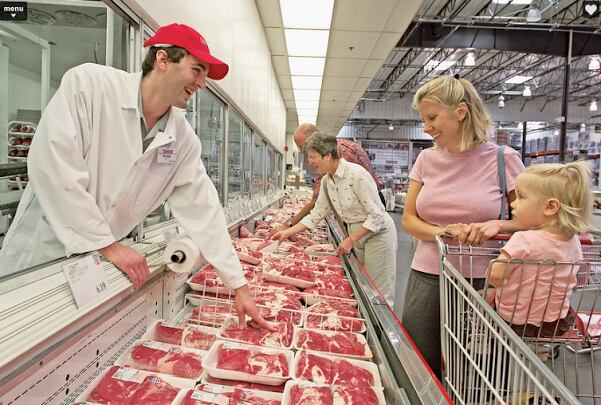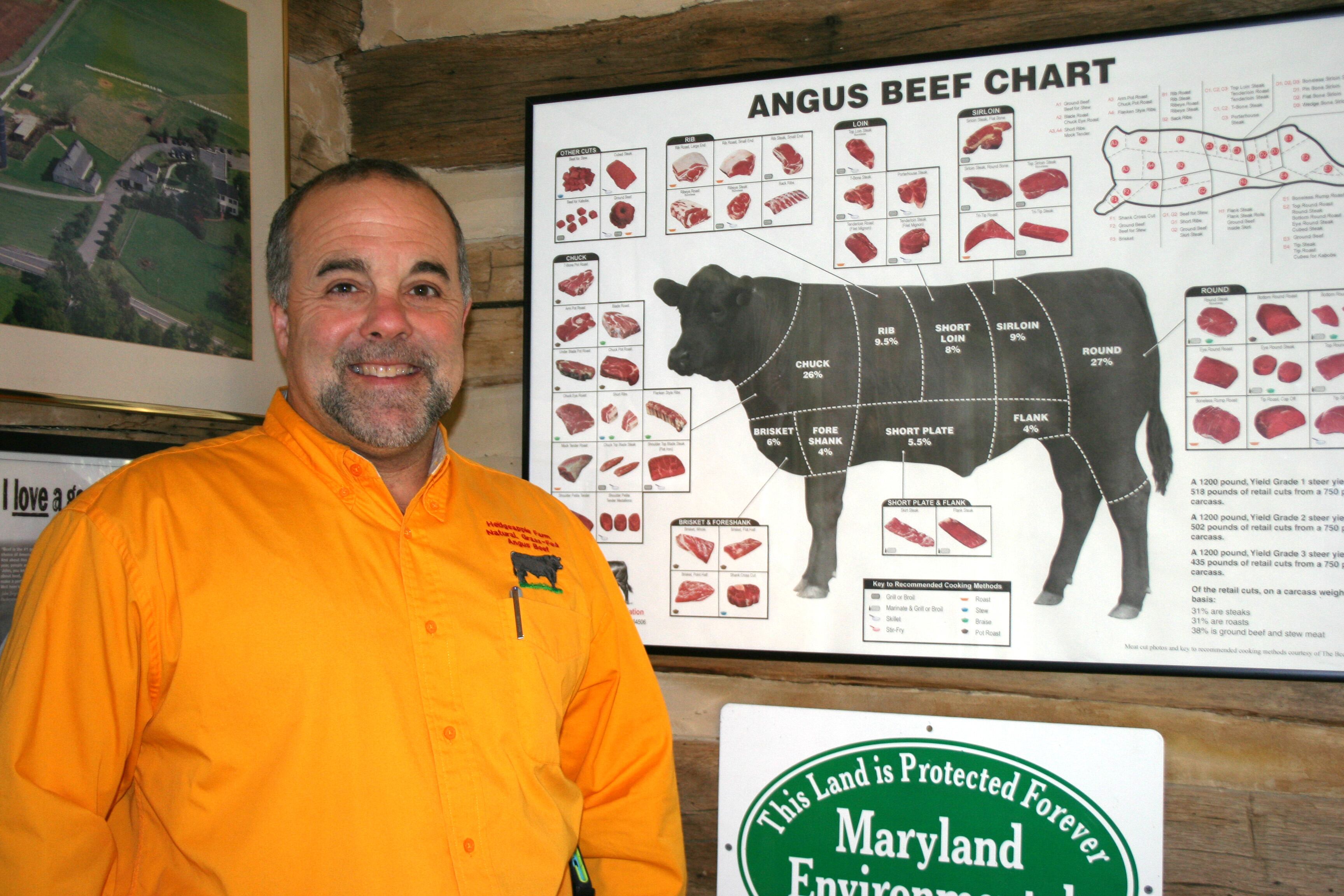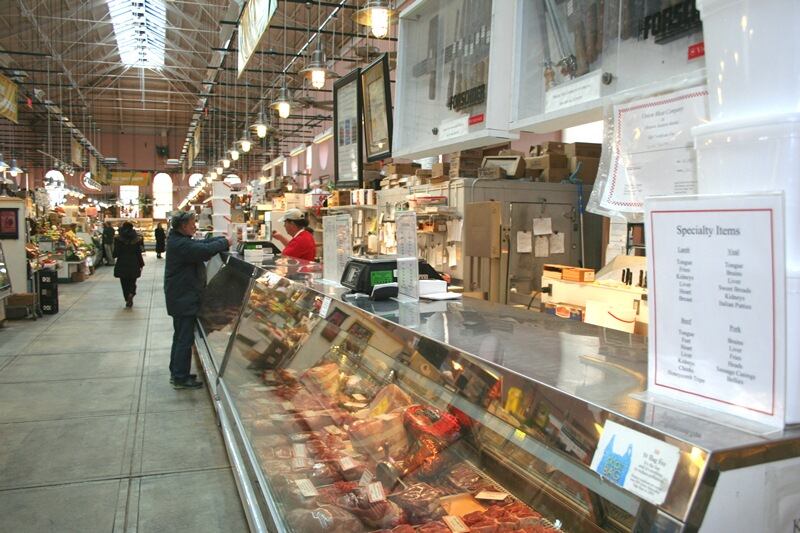This trend is apparent across all retail sectors, from supermarkets to club stores to butchers’ shops, according to a comprehensive 2014 survey published by the American Meat Institute (AMI). Other key trends include a consumer focus on nutritional value, brand preference, sustainability of farming stock and availability of information at the meat counter, according to retailers interviewed.
Some 62% of American shoppers buy their meat at supermarkets; 23% buy at a multi-product hypermarket, such as Walmart; 7% buy at a wholesale-oriented club store such as Costco; 5% at a butcher’s shop; and 3% at organic or speciality stores.
American spending on groceries is rising as its economy recovers from the recession. In 2014, thus far, it has risen to an average of US$108 per week in total versus US$103 last year – with meat featuring on average in 3.8 dinners per week. Some 94% of consumers who cook at home include a meat item at least once a week, according to the AMI. This yields a lot of sales: American per-capita spending on beef, pork, chicken and turkey was US$628.58 annually in 2012 or US$12.08 weekly, according to the AMI. Annual per capita spending on beef was US$287.65; pork US$160.06; chicken US$154.14; and turkey US$26.73.
The increased focus on the origin of retail-sold meat – and on how best to prepare cuts – is reflected in everyday customer questions to butchers at in-store meat counters, according to Bob Huskey, assistant general merchandising manager at Costco, America’s leading warehouse club store. "We take a lot of pride in the fact we are one of the remaining retailers that have on-site butchers. That’s what our members like, they’re not walking up to a meat case that’s 100% pre-packaged. We have our grinders out in the open, under the window; we want consumers to feel comfortable with our programme. That gives us a bit of an edge on our competition."

Beef represents 45% of Costco’s total meat department sales, with poultry and seafood equal at 25% and pork and lamb making up the balance, Huskey says. Ground beef is the most popular beef product, with boneless, skinless breasts the most popular chicken product, and the highest-selling product overall. Costco’s meat and poultry is almost always sold fresh.
Most of Costco’s beef comes from major suppliers, including Cargill, JBS and National Beef; its chicken from Foster Farms and Pilgrim’s Price. Products are largely labelled under Costco’s in-house brand, Kirkland, an integral part of a sales strategy predicated on customer loyalty, spread through word-of-mouth from positive consumer in-store experiences, Huskey says.
Costco has also expanded its organic and natural produce, reflecting increased customer demand. It has two organic items in its top 10 selling products – boneless chicken breasts and ground beef, which the company produces at its in-house facility in California. Some 34% of shoppers have bought organic or naturally raised meat in the past three months, according to the AMI, the highest number since its surveys began in 2007.
It is a trend that hasn’t gone unnoticed by Dr Scott Barao, executive vice-president of the Maryland Cattlemen’s Association and owner of the largest grass-fed beef operation on America’s east coast, near Frederick, Maryland. On a busy Friday, a slew of customers buys fresh and frozen cuts processed from the some 700-head of cattle at Barao’s 550-acre Hedgeapple Farm, as Barao dispenses advice on cooking certain pre-packaged, hard-to-find cuts of beef to loyal customers. Preparation guides line the walls and restored barn-wood shelves.

Barao says there is a clear, growing demand in America for locally produced food. "Consumers want a connection with their food, and meat is a big part of that. The fear that consumers have of the global food supply is driving a desire to purchase local."
Barao is ideally positioned to supply the high-spending residents of Washington, DC, and Baltimore, Maryland, whom he says are increasingly making the 25-mile drive to buy his products. He sells the equivalent of some 150 head of cattle direct to the consumer through his farm store annually.
"Consumers today are very poorly informed in cooking and selection of cuts of meat, and we excel in customer service. We help them with cut selection and recipes. As a result we sell cuts that a consumer may not pick up in a grocery store, as they may not know what to do with them."

Barao says cattlemen’s organisations across the US are heeding customers’ calls for greater transparency in food supply, and smaller, family-owned beef suppliers are marketing their products accordingly.
Such trends help specialist retailers as well as farm-gate sales. Pork, chicken and beef in all manner of shapes and sizes, sourced from across America, are sold at the family-owned Union Meat Company butcher in Washington DC’s historic Eastern Market.
Bill Glasgow Jr and his son, Bill Glasgow III, specialise in prime and choice cuts of aged Black Angus steak and beef cuts ground to order on-site. They also offer whole suckling pigs for family celebrations, and speciality items, including brains, bellies, tongue, heads and feet, which often appeal to the capital’s immigrant and foodie populations. Union Meat Company also sells game – for instance bison – and locally-raised lamb. Glasgow Jr’s father opened Union Meat in 1946: "It’s third-generation family-owned. That’s what keeps our customers coming back," he claims.

Meanwhile, beef total retail sales across the US rose 1.8% year-on-year in 2013, with prices increasing 2.2% year-on-year, according to the AMI. In 2014, Americans were projected to consume 54.1lb of beef per capita.
Changing consumer attitudes are also reflected in demand for poultry, according to Gwen Venable at the US Poultry and Egg Association, who says that buyers are looking for greater transparency in the food chain and are increasingly concerned about antibiotics in poultry production. She says there has also been increased consumer focus on food safety amid bacterial health scares, including salmonella and campylobacter outbreaks.
US chicken total sales rose 7% year-on-year in 2013, with prices increasing 5.1% year-on-year, according to the National Chicken Council. The most popular product was boneless/skinless chicken breasts, according to the US Department of Agriculture (USDA). Americans will consume 84.7lb of chicken per capita in 2014. Meanwhile, pork total sales rose 0.7% year-on-year in 2013, with prices decreasing 1.2% year-on-year, according to the National Pork Board. Per capita consumption of pork was projected at 47.3lb in 2014.
Steve Meyer, a consulting economist to the National Pork Board and the National Pork Producers Council, said that pork sales were hit this year by America’s outbreak of porcine epidemic diarrhoea virus, which made national news. But they have been revived by another health-related story – a recalibrating of expert opinion of the effects of saturated fats on cholesterol levels, which has benefited a wide range of meats regarding retail sale. At the same time, the pigmeat industry has ramped up efforts to portray pork as an alternative to steak for barbecuing and on the dinner table, with its recently launched ‘Grill It Like A Steak’ nationwide marketing initiative.
